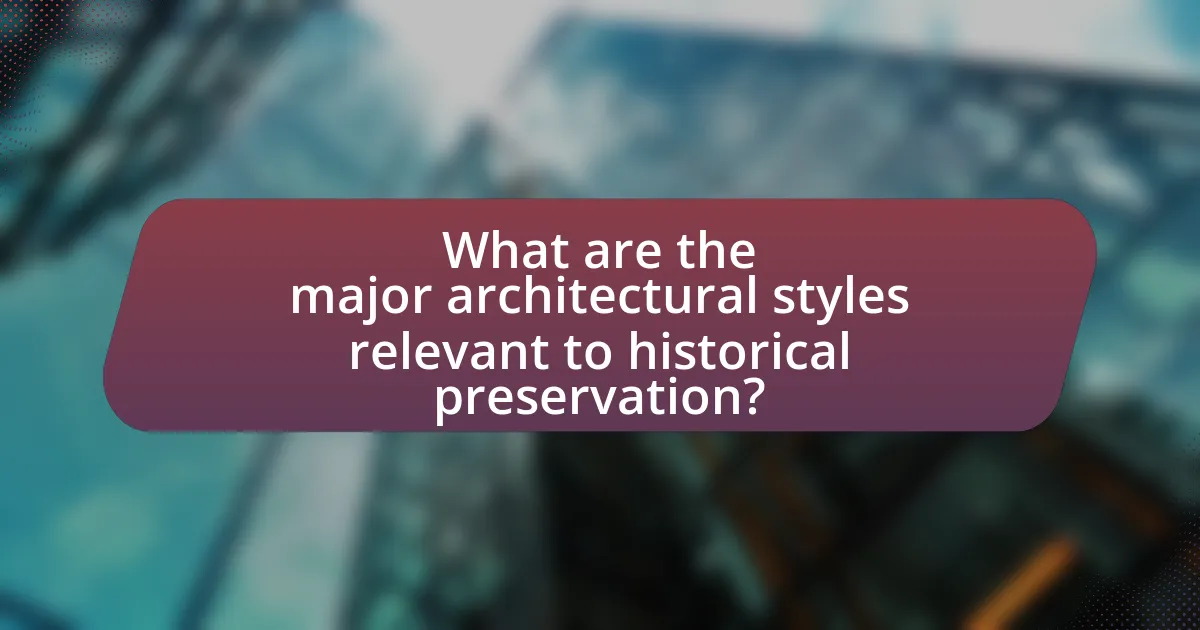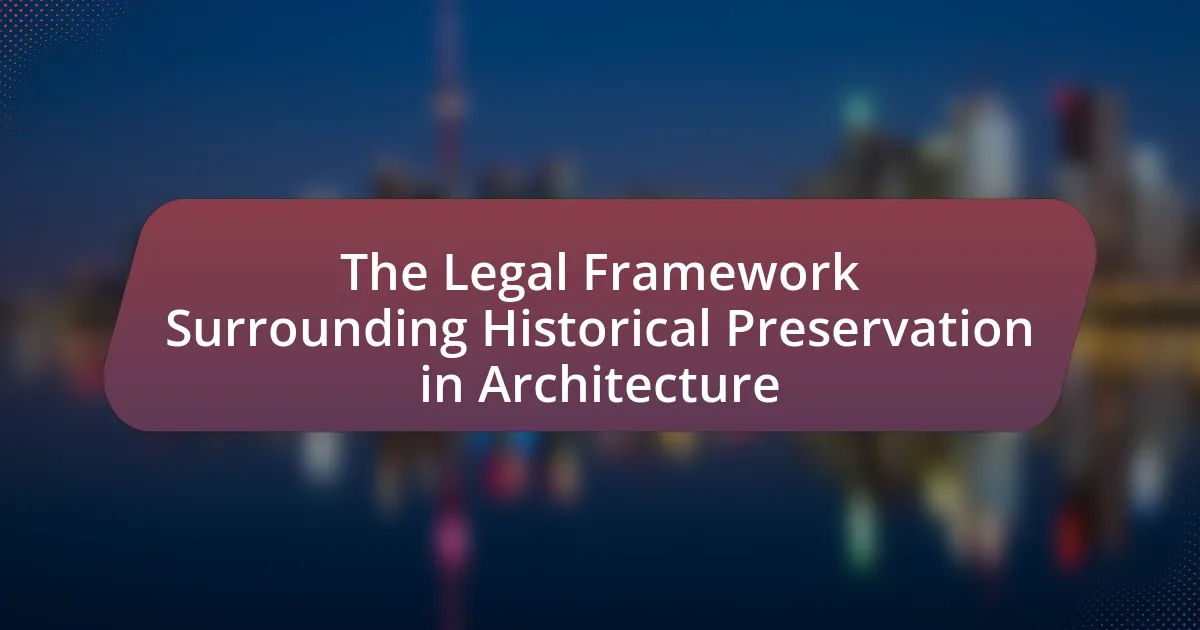Architectural styles in historical preservation encompass the unique design characteristics and construction methods that define buildings from various historical periods. This article examines how different architectural styles, such as Gothic, Colonial, and Modernist, influence preservation efforts, including the techniques and materials used to maintain historical integrity. It highlights the significance of understanding these styles in preserving cultural heritage and community identity, while also addressing the challenges faced in preservation, such as funding limitations and regulatory hurdles. Additionally, the article discusses the role of technology and best practices in enhancing preservation efforts, ensuring that historical architectural styles remain relevant and appreciated by future generations.

What are Architectural Styles in Historical Preservation?
Architectural styles in historical preservation refer to the distinct design characteristics and construction methods that define buildings from specific periods or movements in history. These styles, such as Gothic, Baroque, Colonial, and Modernist, are preserved to maintain cultural heritage and historical significance. For instance, the Gothic style, characterized by pointed arches and ribbed vaults, reflects the architectural innovations of the Middle Ages, while Colonial styles showcase the influences of European settlers in America. Preservation efforts often involve restoring or maintaining these architectural features to ensure that future generations can appreciate the historical context and aesthetic values they represent.
How do different architectural styles influence historical preservation efforts?
Different architectural styles significantly influence historical preservation efforts by dictating the criteria for what is considered historically valuable and how restoration should be approached. For instance, Gothic architecture often requires specific materials and techniques that reflect its intricate design, while Modernist structures may prioritize functionality and minimalism in preservation. The preservation of Colonial buildings often emphasizes authenticity in materials and craftsmanship, as seen in the restoration of Williamsburg, Virginia, where original building techniques are meticulously replicated. These varying requirements based on architectural styles shape the guidelines set by preservation organizations, such as the National Park Service, which provides specific standards for different styles to ensure that restorations maintain historical integrity.
What are the key characteristics of various architectural styles?
Key characteristics of various architectural styles include distinct design elements, materials, and historical contexts that define their aesthetic and functional purposes. For example, Gothic architecture is characterized by pointed arches, ribbed vaults, and flying buttresses, which were used to create height and light in cathedrals during the Middle Ages. In contrast, Neoclassical architecture emphasizes symmetry, columns, and the use of marble, reflecting the influence of ancient Greek and Roman designs in the 18th and 19th centuries. Additionally, Modernist architecture is marked by minimalism, open spaces, and the use of industrial materials like glass and steel, emerging in the early 20th century as a response to traditional forms. Each style not only reflects the technological advancements of its time but also the cultural and social values, making them significant in the study of historical preservation.
How do these characteristics impact preservation techniques?
The characteristics of architectural styles significantly impact preservation techniques by dictating the methods and materials used to maintain historical integrity. For instance, the unique features of Gothic architecture, such as pointed arches and ribbed vaults, require specialized restoration techniques that respect the original craftsmanship. Similarly, the preservation of Colonial styles often involves using period-appropriate materials like wood and lime mortar, which align with historical building practices. These specific requirements ensure that the preservation efforts not only maintain the aesthetic qualities of the structures but also uphold their historical significance, as evidenced by the guidelines set forth by organizations like the National Park Service, which emphasize the importance of authenticity in preservation practices.
Why is understanding architectural styles important in historical preservation?
Understanding architectural styles is crucial in historical preservation because it enables accurate restoration and conservation of buildings that reflect cultural heritage. Recognizing distinct architectural styles allows preservationists to maintain the integrity of historical structures, ensuring that renovations respect original design elements and materials. For instance, the National Historic Preservation Act of 1966 emphasizes the importance of preserving the character of historic properties, which is directly tied to their architectural styles. This understanding helps prevent the loss of historical significance and promotes educational opportunities about the past, thereby fostering community identity and continuity.
What role do architectural styles play in cultural identity?
Architectural styles significantly shape cultural identity by reflecting the values, beliefs, and historical experiences of a community. These styles serve as visual representations of cultural heritage, influencing how societies perceive themselves and their history. For instance, the Gothic architecture of medieval Europe symbolizes religious devotion and societal structure, while traditional Japanese architecture emphasizes harmony with nature and simplicity, showcasing cultural philosophies. The preservation of these architectural styles in historical contexts reinforces community identity and continuity, as seen in UNESCO World Heritage Sites, which protect structures that embody cultural significance and collective memory.
How can architectural styles affect public perception of historical sites?
Architectural styles significantly influence public perception of historical sites by shaping aesthetic appreciation and cultural identity. For instance, Gothic architecture often evokes feelings of grandeur and historical significance, leading to a more favorable public perception, while Brutalist structures may be viewed as uninviting or harsh, affecting their reception negatively. Research indicates that the visual appeal of a building can enhance visitor engagement; a study published in the Journal of Urban Design found that aesthetically pleasing historical sites attract 30% more visitors compared to less visually appealing counterparts. Thus, the architectural style not only impacts how a site is perceived but also its ability to draw public interest and foster community pride.

What are the major architectural styles relevant to historical preservation?
The major architectural styles relevant to historical preservation include Gothic Revival, Neoclassical, Victorian, Art Deco, and Mid-Century Modern. Gothic Revival, characterized by pointed arches and intricate detailing, emerged in the 19th century and is often preserved in churches and universities. Neoclassical architecture, with its emphasis on symmetry and columns, reflects the ideals of ancient Greece and Rome, making it significant in civic buildings. Victorian architecture, known for its ornate designs and eclectic styles, represents the prosperity of the 19th century and is commonly found in residential areas. Art Deco, popular in the 1920s and 1930s, features geometric shapes and bold colors, often seen in commercial buildings. Mid-Century Modern, emerging in the post-World War II era, emphasizes simplicity and integration with nature, making it relevant in suburban developments. Each of these styles holds historical significance and contributes to the cultural heritage that preservation efforts aim to protect.
Which architectural styles are most commonly preserved?
The architectural styles most commonly preserved include Gothic, Romanesque, Colonial, and Art Deco. These styles are frequently maintained due to their historical significance and cultural value. For instance, Gothic architecture, characterized by its pointed arches and ribbed vaults, is often preserved in cathedrals and churches across Europe, reflecting the era’s religious and artistic priorities. Romanesque structures, with their robust and solid forms, are preserved for their representation of early medieval architecture. Colonial styles, particularly in North America, are maintained for their historical connection to early settlers and the formation of new societies. Art Deco, known for its decorative elements and geometric shapes, is preserved in urban settings as a representation of early 20th-century design trends. These styles are prioritized in preservation efforts due to their unique characteristics and the narratives they embody within cultural heritage.
What defines Gothic architecture in the context of preservation?
Gothic architecture in the context of preservation is defined by its distinctive structural elements, such as pointed arches, ribbed vaults, and flying buttresses, which require specific conservation techniques to maintain their integrity. These features not only contribute to the aesthetic and historical significance of Gothic structures, like cathedrals and churches, but also pose unique challenges in preservation efforts due to their intricate designs and the materials used, such as limestone and stained glass. Preservation practices often involve careful restoration of these elements to ensure that the original architectural intent and historical context are respected, as seen in the restoration of Notre-Dame Cathedral after the 2019 fire, where efforts focused on maintaining the original Gothic style while integrating modern safety standards.
How does Neoclassical architecture influence preservation practices?
Neoclassical architecture influences preservation practices by establishing a framework that emphasizes symmetry, proportion, and the use of classical elements in restoration efforts. This architectural style, which emerged in the 18th century, encourages the preservation of historical buildings by adhering to these classical principles, ensuring that renovations maintain the original aesthetic and structural integrity. For instance, the preservation of the Pantheon in Paris showcases how Neoclassical ideals guide restoration techniques, focusing on authentic materials and design elements that reflect the original construction. This adherence to Neoclassical standards not only aids in maintaining historical accuracy but also enhances cultural heritage, as seen in various preservation projects worldwide that prioritize these classical characteristics.
How do regional variations in architectural styles affect preservation?
Regional variations in architectural styles significantly affect preservation by influencing the methods and criteria used to maintain historical structures. Different regions often have unique architectural characteristics shaped by local materials, climate, cultural influences, and historical contexts, which necessitate tailored preservation strategies. For instance, the preservation of adobe structures in the Southwestern United States requires specific techniques to address issues like moisture and temperature fluctuations, while Gothic cathedrals in Europe demand different conservation approaches due to their stone construction and intricate designs. The National Park Service in the U.S. emphasizes the importance of understanding these regional styles in its preservation guidelines, highlighting that effective conservation must respect the original architectural intent and local context.
What are the unique features of regional architectural styles?
Regional architectural styles are characterized by distinct features that reflect local culture, climate, materials, and historical influences. These styles often incorporate specific building techniques and designs that are adapted to the environment, such as the use of local stone or wood, which enhances sustainability and aesthetic appeal. For example, adobe structures in the Southwestern United States are designed to withstand extreme temperatures, while Victorian architecture in England showcases intricate detailing and ornate facades that reflect the industrial era’s wealth. Additionally, regional styles often include elements that symbolize cultural identity, such as the use of traditional motifs or layouts that are significant to local communities. This connection to place and identity reinforces the importance of preserving these unique architectural styles in historical contexts.
How do local climates and materials influence these styles?
Local climates and materials significantly influence architectural styles by dictating design elements that enhance functionality and sustainability. For instance, in arid regions, thick walls and small windows are common to minimize heat gain, while in colder climates, steep roofs and large windows are utilized to facilitate snow shedding and maximize sunlight. Additionally, the availability of local materials, such as adobe in desert areas or timber in forested regions, shapes construction techniques and aesthetic choices, leading to distinct regional styles. Historical examples include the use of limestone in Mediterranean architecture, which is abundant and provides thermal mass, and the use of thatch in tropical climates, which offers effective insulation and is readily available.

What challenges arise in preserving architectural styles?
Preserving architectural styles faces several challenges, including funding limitations, changing regulations, and the need for skilled labor. Funding limitations often hinder restoration projects, as securing financial resources for preservation can be difficult, especially for historically significant structures that require extensive repairs. Changing regulations can complicate preservation efforts, as new building codes or zoning laws may conflict with the original architectural intent. Additionally, the scarcity of skilled labor trained in traditional construction techniques poses a significant challenge, as many craftsmen with the necessary expertise are retiring without sufficient replacements. These factors collectively threaten the integrity and continuity of architectural styles in historical preservation.
What are the common obstacles faced in historical preservation?
Common obstacles faced in historical preservation include funding limitations, regulatory challenges, and community opposition. Funding limitations often arise due to the high costs associated with restoration and maintenance of historical sites, which can deter investment. Regulatory challenges stem from complex legal frameworks that govern preservation efforts, making it difficult to navigate necessary permits and compliance requirements. Community opposition can occur when local residents disagree with preservation plans, often due to concerns about changes to neighborhood character or property values. These obstacles collectively hinder effective preservation efforts and can lead to the deterioration or loss of significant historical sites.
How do funding and resource limitations impact preservation efforts?
Funding and resource limitations significantly hinder preservation efforts by restricting the availability of necessary financial support and materials. These constraints lead to inadequate maintenance of historical sites, resulting in deterioration and loss of architectural integrity. For instance, a study by the National Trust for Historic Preservation indicates that insufficient funding can delay restoration projects, causing further damage and escalating costs over time. Additionally, limited resources often force preservationists to prioritize certain projects over others, which can lead to the neglect of culturally significant structures.
What legal and regulatory challenges exist in preserving architectural styles?
Legal and regulatory challenges in preserving architectural styles include zoning laws, building codes, and property rights issues. Zoning laws can restrict modifications to historical buildings, making it difficult to adapt them for modern use while maintaining their original architectural integrity. Building codes may impose safety and accessibility requirements that conflict with preservation efforts, often necessitating alterations that compromise historical features. Additionally, property rights issues can arise when owners wish to alter or demolish structures deemed historically significant, leading to disputes between preservationists and property owners. These challenges are evident in various case studies, such as the preservation efforts in cities like New Orleans, where local regulations aim to protect architectural heritage but can also hinder property development and personal freedoms.
How can modern interventions respect historical architectural styles?
Modern interventions can respect historical architectural styles by employing design principles that harmonize contemporary elements with traditional aesthetics. This approach includes using materials that complement the original structure, maintaining scale and proportion, and incorporating architectural details that reflect the historical context. For instance, the renovation of the Tate Modern in London preserved the industrial character of the former power station while introducing modern functionality, demonstrating a successful blend of old and new. Such interventions not only honor the historical significance but also enhance the usability of the space, ensuring that the architectural heritage remains relevant in contemporary society.
What best practices should be followed for modern adaptations?
Best practices for modern adaptations in architectural styles include maintaining historical integrity, using compatible materials, and ensuring functionality. Maintaining historical integrity involves preserving key architectural features that define the original style, which helps retain cultural significance. Using compatible materials ensures that new additions harmonize with existing structures, promoting aesthetic continuity. Ensuring functionality means that adaptations should meet contemporary needs while respecting the original design, as seen in successful projects like the Tate Modern in London, which transformed a former power station into a vibrant cultural space without compromising its historical essence.
How can technology aid in the preservation of architectural styles?
Technology aids in the preservation of architectural styles through advanced documentation, restoration techniques, and virtual simulations. Digital tools such as 3D scanning and Building Information Modeling (BIM) allow for precise documentation of existing structures, capturing intricate details that can be used for restoration. For instance, 3D scanning can create accurate digital replicas of historical buildings, which serve as references for repairs and renovations. Additionally, augmented reality (AR) and virtual reality (VR) technologies enable stakeholders to visualize restoration projects and assess the impact on architectural integrity before physical work begins. These methods not only enhance the accuracy of preservation efforts but also facilitate public engagement and education about architectural heritage.
What practical tips can be applied to enhance architectural preservation efforts?
To enhance architectural preservation efforts, stakeholders should prioritize community engagement and education. Engaging local communities fosters a sense of ownership and responsibility towards historical sites, which can lead to increased advocacy for preservation. Educational programs can inform the public about the historical significance of architectural styles, encouraging support for preservation initiatives. For instance, studies show that communities with active preservation programs often see a 20% increase in local tourism, which can provide funding for maintenance and restoration projects. Additionally, implementing strict zoning laws and guidelines can protect historical sites from inappropriate development, ensuring that architectural integrity is maintained.





